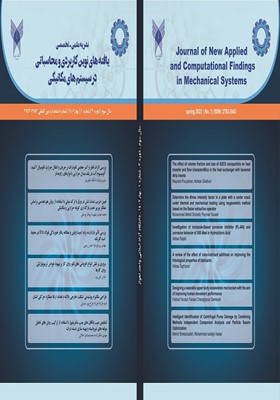طراحی مکانیزم پوشیدنی اسکلت خارجی بالاتنه با هدف ارتقا عملکرد حرکتی انسان
محورهای موضوعی : یافته های نوین کاربردی و محاسباتی در سیستم های مکانیکی
فربد فرزاد
1
,
فرزاد چراغ پور سموتی
2
![]()
1 - دانشجوی کارشناسی ارشد، گروه مهندسی مکانیک، واحد پردیس، دانشگاه آزاد اسلامی، تهران، ایران
2 - استادیار، گروه مهندسی مکانیک، واحد پردیس، دانشگاه آزاد اسلامی، تهران، ایران
کلید واژه: ربات پوشیدنی, اسکلت خارجی, طراحی ربات, بالاتنه, ربات همیار,
چکیده مقاله :
مکانیزمها و رباتهای پوشیدنی برای ارتقا عملکرد انسان و به فرم بدن طراحی میشوند و هدف از طراحی آنها کمک به انسان در تعامل بهتر با محیط در انجام وظایف تعریف شده است. ارتقا عملکرد فرد میتواند شامل خستگی کمتر در انجام فعالیت، محافظت در مقابل آسیبهای جسمی حاصل از کارهای سنگین، ظرفیت حمل بار بیشتر توسط فرد و یا سرعت بالاتر در اجرای حرکات باشد. مکانیزم رباتیک اسکلت خارجی بالاتنه اوبر (UBER) به عنوان یک مکانیزم آسانپوش، انعطافپذیر و قابلتنظیم برای جلوگیری از آسیبهای معمول، بیماریهای عضلانی، اسکلتی، نخاعی و مفاصل طراحی شده است. هدف از طراحی این ربات کمک حرکتی برای یک کارگر ماهر، اجرای وظایف تخصصی مانند عملیات مونتاژکاری در یک خط تولید در مدت زمان نسبتا زیاد، با خستگی کمتر میباشد و همچنین به راحتی از ابزارهای مورد نیاز خود استفاده کند. تحلیلهای تنش و کرنش انجام شده با بارگذاری 5 کیلوگرم، نشان میدهد که بازو علاوه بر تحمل وزن دست کاربر، قابلیت جابجایی بار را نیز تا 3 کیلوگرم دارا میباشد. با توجه به گستره حرکتی ربات طراحی شده و تعداد درجات آزادی آن، استفاده از این ربات در دراز مدت موجب حفظ سلامتی اسکلتی کارگر ماهر شده و بدین ترتیب با کاهش هزینههای سلامت نیروی کار، بهرهوری تولید را ارتقا خواهد داد.
Wearable mechanisms and robots are designed to improve human performance and body shape, and their design aims to help humans interact better with the environment. By using this human-connected mechanism, it is possible to help disabled people in more appropriate performance of movement activities such as walking, sitting and standing up, as well as in lifting objects that they are normally unable to lift. Improving a person's performance can include less fatigue in performing activities, protection against physical injuries resulting from heavy work, a person's capacity to carry more load, or a higher speed in performing movements. The upper body exoskeleton robotic mechanism (UBER) is designed as an easy-to-wear, flexible and adjustable mechanism to prevent common injuries, musculoskeletal, spinal and joint diseases. The purpose of developing this mobility aid robot for a skilled worker is to perform specialized tasks such as assembly operations in a production line in a relatively long period of time, with less fatigue and also to use the tools he needs easily. The stress and strain analysis performed with a load of 5 kilograms shows that the arm, in addition to bearing the weight of the user's hand, can also move a load of up to 3 kilograms. Considering the range of motion of the designed robot and the number of degrees of freedom, using this robot in the long term will maintain the skeletal health of the skilled worker, thus increasing production efficiency by reducing labor health costs.
[1] Gull, M.A., Bai, S. Bak, T., (2020), A review on design of upper limb exoskeletons, Robotics, 9(1), pp. 16-26.
[2] Islam, M.R., Spiewak, C., Rahman, M.H., Fareh, R. A., (2017), Brief Review on Robotic Exoskeletons for Upper Extremity Rehabilitation to Find the Gap between Research Porotype and Commercial Type, Advanced in Robotics and Autonomous, 6, pp. 408–417.
[3] Gopura, R., Bandara, D., Kiguchi, K., Mann, G.K., (2016), Developments in hardware systems of active upper-limb exoskeleton robots: A review, Robotics and Autonomous Systems, 75, pp. 203–220.
[4] Stewart, A.M., Pretty, C.G., Adams, M., Chen, X., (2017), Review of Upper Limb Hybrid Exoskeletons, IFAC PapersOnLine 2017, 50, pp. 15169–15178.
[5] Gupta, S., Agrawal, A., Singla, E., (2019), Wearable Upper Limb Exoskeletons: Generations, Design Challenges and Task Oriented Synthesis, New Trends in Medical and Service Robotics, pp. 134-142.
[6] Graham, R.B., Agnew, M.J. Stevenson, J.M., (2009), Effectiveness of an on-body lifting aid at reducing low back physical demands during an automotive assembly task: Assessment of EMG response and user acceptability, Applied Ergonomics, 40(5), pp.936-942.
[7] Mauri, A., Lettori, J., Fusi, G., Fausti, D., Mor, M., Braghin, F., Roveda, L. (2019), Mechanical and control design of an industrial exoskeleton for advanced human empowering in heavy parts manipulation tasks, Robotics, 8(3), pp. 65-75.
[8] Kermavnar, T., de Vries, A.W., de Looze, M..P., O’Sullivan, L.W., (2020), Effects of industrial back-support exoskeletons on body loading and user experience: an updated systematic review, Ergonomics, pp.1-48.
[9] Voilque, A., Masood, J., Fauroux, JC., Sabourin, L., Guezet O., (2019), Industrial Exoskeleton Technology: Classification, Structural Analysis, and Structural Complexity Indicator. in Proceedings IEEE, Wearable Robotics Association Conference (WearRAcon), pp. 13-20.
_||_

